I've been doing some image processing recently, and am looking for a javascript solution to determine the longest line segment that is entirely within a non-regular shape. To sum it up, the line segment should be the longest line segment that touches the shape and not overlaps or moves outside of the shape.
Here are the steps which I have followed
step 1:
step 2:
step 3:
as shown in step 3 Blue line indicates max length. It is working perfectly to determine the length of regular shapes, but in case of irregular shapes it is not working (also in the case of 3 points).
To calculate length first I have taken points (which are mouse coordinates on the canvas down event.
Here is the snippet for Canvas down :
function getXY(e) {
var el = document.getElementById('canvas');
var rect = el.getBoundingClientRect();
/* console.log("widht "+$("#canvas").width());
console.log("heihgt "+$("#canvas").height());
console.log("X "+Math.round(e.clientX - rect.left));
console.log("y "+Math.round(e.clientY - rect.top));*/
return {
x: Math.round(e.clientX - rect.left),
y: Math.round(e.clientY - rect.top)
}
}
$('#canvas').mousedown(function(e) {
var can = document.getElementById("canvas");
var ctx = can.getContext('2d');
if (condition == 1) {
if (e.which == 1) {
//store the points on mousedown
var poss = getXY(e);
i = i + 1;
if (firstX == poss.x && firstY == poss.y) {
console.log(" inside if poss.x===" + poss.x + " poss.y===" + poss.y);
//$('#crop').click();
} else {
console.log(" inside else poss.x===" + poss.x + " poss.y===" + poss.y);
points.push(Math.round(poss.x), Math.round(poss.y));
pointsforline.push({ "x": Math.round(poss.x), "y": Math.round(poss.y) });
xarray.push(poss.x);
yarray.push(poss.y);
sendpoints.push(Math.round(poss.x), Math.round(poss.y));
if(points.length >= 6){
$('#fixMarkingBtn').show();
}
}
// Type 1 using array
if(points.length == 6 && sendpoints.length ==6 ){
$('#fixMarkingBtn').show();
}
// Type 2 using counter
/* if (i == 3) {
$('#fixMarkingBtn').show();
}*/
if (i == 1) {
$('#undoMarkingBtn').show();
$('#resetMarkingBtn').show();
firstX = poss.x;
firstY = poss.y;
//change is here
Xmax = poss.x;
Ymax = poss.y;
Xmin = poss.x;
Ymin = poss.y;
minX1 = poss.x;
maxY1 = poss.y;
minX1 = poss.x;
minY1 = poss.y;
}
if (poss.x < Xmin) {
Xmin = poss.x;
minY1 = poss.y;
}
if (poss.x > Xmax) {
Xmax = poss.x;
maxY1 = poss.y;
}
if (poss.y < Ymin) {
Ymin = poss.y;
minX1 = poss.x;
}
if (poss.y > Ymax) {
Ymax = poss.y;
maxX1 = poss.x;
}
ctx.globalCompositeOperation = 'source-over';
var oldposx = $('#oldposx').html();
var oldposy = $('#oldposy').html();
var posx = $('#posx').html();
var posy = $('#posy').html();
ctx.beginPath();
ctx.lineWidth = 13;
ctx.moveTo(oldposx, oldposy);
if (oldposx != '') {
ctx.lineTo(posx, posy);
ctx.stroke();
}
$('#oldposx').html(poss.x);
$('#oldposy').html(poss.y);
}
ctx.fillStyle = 'red';
ctx.strokeStyle = 'red';
ctx.fillRect(posx, posy, 10, 10);
$('#posx').html(posx);
$('#posy').html(posy);
} //condition
});
here is the code I have used (point of problem) :
function calMaxMin() {
for (var i = 0; i < points.length; i += 2) {
if (i == 0) {
Xmax = points[i];
Ymax = points[i + 1];
Xmin = points[i];
Ymin = points[i + 1];
minX1 = points[i];
maxY1 = points[i + 1];
minX1 = points[i];
minY1 = points[i + 1];
}
if (points[i] < Xmin) {
Xmin = points[i];
minY1 = points[i + 1];
}
if (points[i] > Xmax) {
Xmax = points[i];
maxY1 = points[i + 1];
}
if (points[i + 1] < Ymin) {
Ymin = points[i + 1];
minX1 = points[i];
}
if (points[i + 1] > Ymax) {
Ymax = points[i + 1];
maxX1 = points[i];
}
}
}
Problem image 1
Problem image 2 (what I'm getting right now)
Expected output
Any help would be appreciated.
Thanks in advance!








